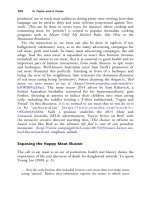The palgrave international handbook of a 320
Bạn đang xem bản rút gọn của tài liệu. Xem và tải ngay bản đầy đủ của tài liệu tại đây (28.17 KB, 1 trang )
318
J.E. Mazurek
quantities as [humans] do. For the most part, their primary senses are just as
good, and in many cases better, than our own. When comparing their behavior
to primates, one finds very few differences . . . One must conclude, therefore,
that the level of cognitive complexity displayed by fishes is on a par with most
other vertebrates, and that if any animals are sentient then one must conclude
that fish are too.
In other words, Brown’s (2014) systematic approach establishes that fish fall
squarely within Regan’s (1983) conceptualization of ‘subjects-of-a-life’ and
thus qualify as moral patients deserving protection due to their intrinsic value.
Additionally, Kappeler’s (1995) argument that Regan’s ‘subjects-of-a-life’ framework is ‘super-speciesist’ is partially undercut by Brown’s (2014) findings
that serve to greatly expand the range of species the framework covers beyond
solely mammals. Having firmly situated fish within the two rationalistic moral
pillars at the base of the nonspeciesist animal abuse literature, this chapter can
now interrogate how the discourse of utilitarianism as expressed through calls
for ‘conservation’ and ‘animal welfare’ by zoos and aquariums serves to actually
perpetuate conditions conducive to animal abuse.
The Ideological Work of Public Aquariums and Zoos
As a theoretical tool, Lynch and colleagues’ (2013) use of the political
economic concept of the ‘treadmill of production’ to illuminate the capitalistic crime of ecological disorganization has significant bearing on the
expansion of the animal abuse literature. The ‘treadmill of production’
focuses on capitalism’s imperative to expand and transform ever wider swaths
of nature from, as White (2002, p. 85) puts it, ‘previously unproductive or
noncapitalist forms of activity into sites of productive labor.’ Importantly,
the ‘treadmill of production’ also incorporates an understanding of ecological
additions (pollutants) and withdrawals (‘raw material input into the treadmill and the forms of ecological damage created in accessing those materials’
(Lynch et al. 2013, p. 1003)) that contribute further to ecological disorganization and destruction. Such a framework is powerful in making theoretical sense of individual instances and wider processes of environmental
destruction; its mechanistic metaphor, however, is lacking an explanation
of the lubricating grease that keeps the gears of the treadmill turning. A more
holistic theoretical framework is one that incorporates an understanding of
how the consumption of nature is culturally constructed, and how ideological narratives perpetuate such consumption. This incorporation of ‘cultural









